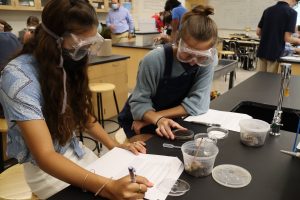September 30, 2021
AP Bio Lab Examines Animal Behaviors
AP Bio is not for the faint of heart, with terrestrial isopods, more commonly known as sow bugs (or roly-polies to the pre-K set), scrambling around in Petri dishes in a classroom in the Chase Tallwood Science Center. Fritz Goodman’s lab, Animal Behavior: Response to Environmental Variables, had the students up close and personal with the land-dwelling crustaceans observing their behavior as it relates to various stimuli.
For the first ten minutes of the class, the students observed the critters undisturbed behavior making notes of their movements. Do they continuously move or settle down?  What happens if two isopods touch each other? The students recorded any agonistic behavior which is aggressive or submissive displays. They observed the bugs’ movements by categorizing them as either taxis, movement directed in relation to a given stimulus, or kinesis, undirected, random movement.
What happens if two isopods touch each other? The students recorded any agonistic behavior which is aggressive or submissive displays. They observed the bugs’ movements by categorizing them as either taxis, movement directed in relation to a given stimulus, or kinesis, undirected, random movement.
In teams of two, the students examined their ten sow bugs as they added a wet filter chamber to one side of the dish. One group of five bugs was added with a sorting brush to the damp side, and the other five were placed on the dry side. For 10 minutes every 30 seconds, the students meticulously counted and recorded the movements of the isopods and then graphed their data based on the independent or dependent variable. Based on their observations, the students needed to answer how the isopods orient with respect to moisture in the environment and how their orientation was achieved whether through taxis or kinesis.
From the experiment, the students concluded that the isopods prefer humid conditions. These bugs absorb oxygen through their gills, and the gills only function when they are wet. Therefore, it’s not uncommon to find pill bugs under a rock or in a rotting piece of wood, places in which the air holds a lot of water.
There was a buzz of activity and intellectual curiosity in the lab with the pairs sharing their information and groups collaborating and conferring with one another. The students exercised their critical thinking abilities, challenging each other’s assumptions. With all that chatter, one has to wonder if the steady hum of human voices during the experiment is factored in as another variable. : )
